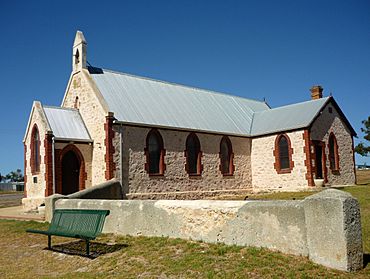Raukkan, South Australia facts for kids
Quick facts for kids RaukkanNarrung, South Australia |
|
|---|---|

Raukkan Church, 2015
|
|
| Population | 106 (2016 census) |
| Location |
|
| LGA(s) | The Coorong District Council |
| State electorate(s) | MacKillop |
| Federal Division(s) | Barker |
Raukkan is an Australian Aboriginal community situated on the south-eastern shore of Lake Alexandrina in the locality of Narrung, 80 kilometres (50 mi) southeast of the centre of South Australia's capital, Adelaide. Raukkan is "regarded as the home and heartland of Ngarrindjeri country."
It was originally established as Point McLeay mission in 1859 and became an Aboriginal reserve in 1916. It was finally handed back to the Ngarrindjeri people in 1974, and renamed Raukkan in 1982.
History
Raukkan, which means "meeting place" in the Ngarrindjeri language, was for thousands of years an important meeting place for Ngarrindjeri "lakalinyeri" (clans) and the location of the Grand Tendi, the parliament of the Ngarrindjeri people. The Grand Tendi was composed of men elected from each of the eighteen lakalinyeri who then elected from its members the Rupulle or leader.
English explorer Charles Sturt first encountered the Ngarrindjeri at Raukkan, who fed the starving Sturt and his party.
In 1860 the Aborigines' Friends' Association was granted 107 hectares in the area and established a mission at Raukkan, which had been named "Point McLeay" by T. B. Strangways in 1837. George Taplin had selected the site, and with others such as the Rev. F. W. Cox helped build the school, church and mission station to care for the local Aboriginals, and spent the next twenty years in that service. It was intended by the Aborigines' Friends' Association to help the Ngarrindjeri people, but could never be self-sufficient farming due to the poor quality of the soil in the area. Land clearing by farmers nearby also limited the ability for hunting, and other crafts and industries also met with difficulties due to changing environment and competition from nearby towns. In 1916, responsibility for Raukkan moved to South Australia's Chief Protector of Aborigines, and since 1974 it has been administered by the Ngarrindjeri people themselves and renamed Raukkan in 1982.
Raukkan Aboriginal School is in the town. In the 2011 Australian Census the population was 99, of whom 95 were Aboriginal and Torres Strait Islander people.
Notable residents
The Mission was mentioned in the Bringing Them Home Report (1997) as an institution housing Indigenous children forcibly removed from their families, creating part of the Stolen Generations.
Raukkan was home to James Unaipon (c. 1835 – 1907) and his son David (1872 – 1967). James Unaipon was the first Australian Aboriginal deacon. and co-authored writings on the Ngarrindjeri language and David was a writer and inventor, who along with the Raukkan Church, is featured on the Australian fifty-dollar note.
Ivaritji (c. 1849 – 1929) was a Kaurna elder and the last known speaker of the Kaurna language.
"Granny" Euniapon was subject of a pastel sketch by Frederick C. Britton purchased by the Art Gallery of South Australia in 1916. (Elsewhere spelled "Unaipon".)
Harry Hewitt (c. 1861 – 1907) was a notable South Australian athlete who spent much of his life based at the Point McLeay mission. He would go on to play football for Medindie and Port Adelaide in a game against Fitzroy.
Roland Carter (1892 – 1960) was a labourer born in Raukkan and was the first Ngarrindjeri man from the Point McLeay Mission Station to enlist in the First Australian Imperial Force. He fought in World War one, was taken prisoner by the Germans and returned to live in Raukkan after being released at the end of the war.
Doreen Kartinyeri (1935 – 2007) was a Ngarrindjeri elder and historian.


